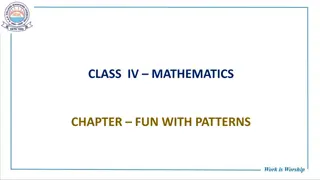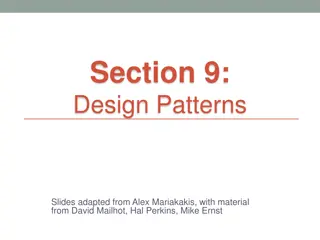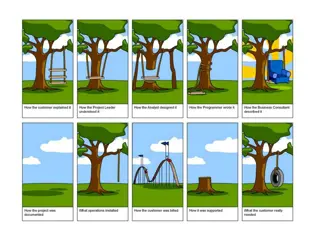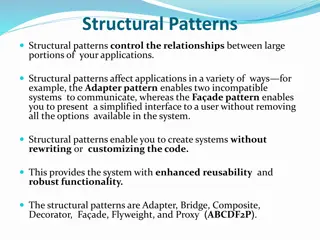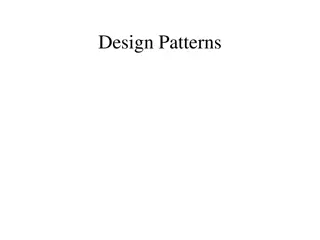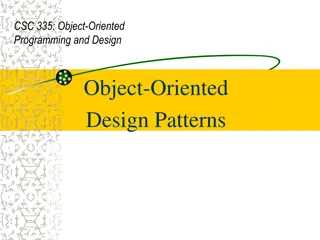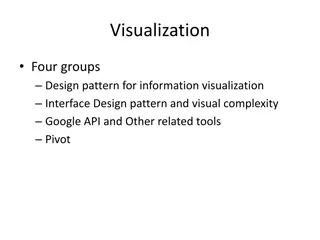Design Patterns Overview and Application Scenarios
Explore various design patterns such as Creational, Structural, and Behavioral patterns, including Adapter, Decorator, Proxy, and more. Learn how to apply these patterns to solve common software design challenges and improve code flexibility and maintainability.
Download Presentation

Please find below an Image/Link to download the presentation.
The content on the website is provided AS IS for your information and personal use only. It may not be sold, licensed, or shared on other websites without obtaining consent from the author.If you encounter any issues during the download, it is possible that the publisher has removed the file from their server.
You are allowed to download the files provided on this website for personal or commercial use, subject to the condition that they are used lawfully. All files are the property of their respective owners.
The content on the website is provided AS IS for your information and personal use only. It may not be sold, licensed, or shared on other websites without obtaining consent from the author.
E N D
Presentation Transcript
Section 10 MATERIAL PULLED FROM LAST SECTION AND LAST YEAR S SLIDES
Todays Agenda Administrivia Review Design Patterns Design Pattern Worksheet Course Review
Administrivia Friday Demos and Couse Wrap-Up It s not too late! Nominate your extra credit work to show off in class! Wednesday 8:30AM Exam (sorry)
Design Patterns Creational patterns: get around Java constructor inflexibility Sharing: singleton, interning, flyweight Telescoping constructor fix: builder Returning a subtype: factories Structural patterns: translate between interfaces Adapter: same functionality, different interface Decorator: different functionality, same interface Proxy: same functionality, same interface, restrict access All of these are types of wrappers
Design Patterns Adapter, Builder, Decorator, Factory, Flyweight, Intern, Model-View-Controller (MVC), Proxy, Singleton, Visitor, Wrapper What pattern would you use to add a scroll bar to an existing window object in Swing Decorator We have an existing object that controls a communications channel. We would like to provide the same interface to clients but transmit and receive encrypted data over the existing channel. Proxy
Worksheet time! Solutions will be posted online
Stronger vs Weaker (one more time!) Requires more? weaker Promises more? (stricter specifications on what the effects entail) stronger
Stronger vs Weaker @requires key is a key in this @return the value associated with key @throws NullPointerException if key is null A. @requires key is a key in this and key != null WEAKER @return the value associated with key B. @return the value associated with key if key is a key in this, or null if key is not associated value NEITHER with any C. @return the value associated with key @throws NullPointerException if key is null STRONGER @throws NoSuchElementException if key is not a key this
Subtypes & Subclasses Subtypes are substitutable for supertypes If Foo is a subtype of Bar, G<Foo> is a NOT a subtype of G<Bar> Aliasing resulting from this would let you add objects of type Bar to G<Foo>, which would be bad! Example: List<String> ls = new ArrayList<String>(); List<Object> lo = ls; lo.add(new Object()); String s = ls.get(0); Subclassing is done to reuse code (extends) A subclass can override methods in its superclass
Typing and Generics <?> is a wildcard for unknown Upper bounded wildcard: type is wildcard or subclass Eg: List<? extends Shape> Illegal to write into (no calls to add!) because we can t guarantee type safety. Lower bounded wildcard: type is wildcard or superclass Eg: List<? super Integer> May be safe to write into.
Subtypes & Subclasses class Student extends Object { ... } class CSEStudent extends Student { ... } x List<Student> ls; ls = lcse; List<? extends Student> les; x les = lscse; List<? super Student> lss; x lcse = lscse; List<CSEStudent> lcse; x les.add(scholar); List<? extends CSEStudent> lecse; x lscse.add(scholar); List<? super CSEStudent> lscse; lss.add(hacker); Student scholar; x CSEStudent hacker; scholar = lscse.get(0); hacker = lecse.get(0);
Subtypes & Overriding class Foo extends Object { Shoe m(Shoe x, Shoe y){ ... } } class Bar extends Foo {...}
Method Declarations in Bar The result is method overriding The result is method overloading The result is a type-error None of the above Object Foo Bar Footwear Shoe HighHeeledShoe FootWear m(Shoe x, Shoe y) { ... } Shoe m(Shoe q, Shoe z) { ... } HighHeeledShoe m(Shoe x, Shoe y) { ... } Shoe m(FootWear x, HighHeeledShoe y) { ... } Shoe m(FootWear x, FootWear y) { ... } Shoe m(Shoe x, Shoe y) { ... } Shoe m(HighHeeledShoe x, HighHeeledShoe y) { ... } Shoe m(Shoe y) { ... } Shoe z(Shoe x, Shoe y) { ... }
Method Declarations in Bar The result is method overriding The result is method overloading The result is a type-error None of the above Object Foo Bar Footwear Shoe HighHeeledShoe FootWear m(Shoe x, Shoe y) { ... } type-error Shoe m(Shoe q, Shoe z) { ... } overriding HighHeeledShoe m(Shoe x, Shoe y) { ... } overriding Shoe m(FootWear x, HighHeeledShoe y) { ... } overloading Shoe m(FootWear x, FootWear y) { ... } overloading Shoe m(Shoe x, Shoe y) { ... } overriding Shoe m(HighHeeledShoe x, HighHeeledShoe y) { ... } overloading Shoe m(Shoe y) { ... } overloading Shoe z(Shoe x, Shoe y) { ... } none (new method declaration)
Exam You got this! We believe in you! Wednesday 8:30AM! Set you alarms now!









